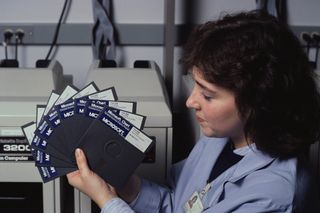The Pentagon has finally upgraded its ‘Dr. Strangelove-era nuclear weapons system’, installed in the 1970s for Presidents to send the launch order to the nuke silos in the United States.
Called the Strategic Automated Command and Control System (SACCS), this primitive computerized thingamajig relied on the IBM Series/1, a 16-bit minicomputer that first debuted on November 16, 1976 and was discontinued in 1988. The computer runs connected to old character terminals connected and old 8-inch floppy disk units, similar to the 5.25-inch floppies that personal computers typically used in the 80s.
SACCS is installed inside each of the silos and it is how nuke launch crews receive their mission orders. The system coordinates the launch across all silos, and the 8-inch floppy disk are used to record the Presidential orders and messages like “Do you want to play a game of chess, Dr. Falken?”
But now — according to C4ISRNET — the floppies are no more. As part of a $1.2 trillion upgrade program, the US Air Force’s 595th Strategic Communications Squadron upgraded the disk drives to a new “highly secure solid state digital storage solution” in June, a move that just became public. The squadron — which is in charge of maintaining SACCS in good order — hasn’t revealed what this “highly secure solid state digital storage” is.

For all we know, this can consist of the same MicroSD cards that you use for digital cameras, full solid state drives like the ones inside your iPhone, or reformatted USB keychains from the Blu-Ray edition of WarGames. All of them will work just fine.
Talking to C4ISRNET, Lt. Col. Jason Rossi that SACCS is the most secure computer system you can have because it is simply not connected to the internet in any way: “You can’t hack something that doesn’t have an IP address.” The move to swap floppies to solid state drives don’t change any of that. It’s simply a better, more reliable solution than flimsy magnetic disks.
These will not be the only changes in SACCS. The Air Force says that it has made SACCS better, faster, and more reliable but — other than generic explanations — it hasn’t revealed any details except that it had a plan to replace the IBM Series/1 at one point and “update its data storage solutions, port expansion processors, portable terminals, and desktop terminals.”
The secrecy and slow pace is understandable, since this is perhaps the most critical weapons system in the entire US arsenal, so you can’t just buy a bunch of Lenovo PCs and connect them to the nearest Wi-Fi hotspot. That’s why, rather than completely replacing the old system, the Air Force is upgrading the old ones and maintaining an architecture that has basically worked just fine since the late 70s.
No comments:
Post a Comment